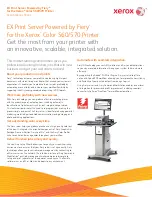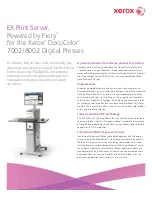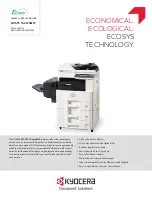
Chapter 4
‐
How to Operate Your Océ Arizona Printer
77
Océ Arizona 6100 Series
Static Suppression System Reduces Static
Static Suppression System Reduces Static
Introduction
The Océ Static Suppression System (sometimes referred to as an Anti-static or Ionizer Bar) is
located on the gantry of your Océ Arizona 6100 Series printer. If you are experiencing static-
related imaging problems this anti-static bar provides a solution to reduce static. Some rigid
media can have a large static surface charge. If the charge is high enough, ink can be repelled
from the media. This ink mist can show up as cloudy areas in white sections of the image. Static
not only causes these printing artifacts, but can also result in excessive ink accumulation on the
bottom of the carriage.
Why Static is a Problem
Many standard print materials such as PVC and acrylic are electrical insulators, and the static
charge generated and held by these materials can provide some printing challenges.
Thermoplastic materials are the most common static-laden print media. Static-prone materials
tend to attract dust and hair and release charges that can be felt and seen.
Purpose
Ionization is a solution to the problem of static. A common print industry method of controlling
static electricity is the use of ionization. For the Océ anti-static bar to be effective, it must be close
to the media so it is mounted to the gantry at an optimal distance. The bar uses AC current to
create positive and negative ions, which are attracted to the unbalanced surface of the material.
This neutralizes the media and ink is more readily accepted. It is important to note that static
electricity cannot be entirely eliminated; only reduced. To eliminate static electricity, something
physically would have to be done to the conductivity of the material.
Humidity is also important to control static. Static-related print issues can be greatly reduced by
an increase in print environment humidity. While most media will print without difficulty at
humidity levels between 30 and 50%, thermoplastics will print more successfully when humidity
is above 40%. Some locales, such as desert areas frequently deal with very low humidity, while
other regions only experience this at certain times of the year. If a printer is installed in a low-
humidity area and/or a large volume of printed work is on media that is prone to static, we
recommend the installation of a humidity control system.
Содержание Arizona 6160 XTS
Страница 1: ...Oc Display Graphics Systems User Guide Oc Arizona 6100 Series Oc Arizona 6100 Series Revision B...
Страница 6: ...Contents 6 Oc Arizona 6100 Series...
Страница 7: ...Chapter 1 Introduction...
Страница 15: ...Chapter 2 Safety Information...
Страница 44: ...44 Chapter 2 Safety Information Oc Arizona 6100 Series Safety Awareness...
Страница 45: ...Chapter 3 How to Navigate the User Interface...
Страница 67: ...Chapter 4 How to Operate Your Oc Arizona Printer...
Страница 79: ...Chapter 5 How to Operate the Vacuum System...
Страница 85: ...Chapter 6 How to Print in Batch and Dual Origin Modes...
Страница 90: ...How to Print in Batch Mode 90 Chapter 6 How to Print in Batch and Dual Origin Modes Oc Arizona 6100 Series...
Страница 91: ...Chapter 7 How to Manage a White Ink Workflow...
Страница 124: ...12 Chapter 7 How to Manage a White Ink Workflow Oc Arizona 6100 Series How to Print White Ink Jobs...
Страница 125: ...Chapter 8 Ink System Management...
Страница 135: ...Chapter 9 Error Handling and Troubleshooting...
Страница 139: ...Chapter 10 Printer Maintenance...
Страница 174: ...174 Chapter 10 Printer Maintenance Oc Arizona 6100 Series How to Bleed an Ink Filter...
Страница 175: ...Appendix A Application Information...
Страница 178: ...Application Resources on the Web Site 178 Appendix A Application Information Oc Arizona 6100 Series...
















































